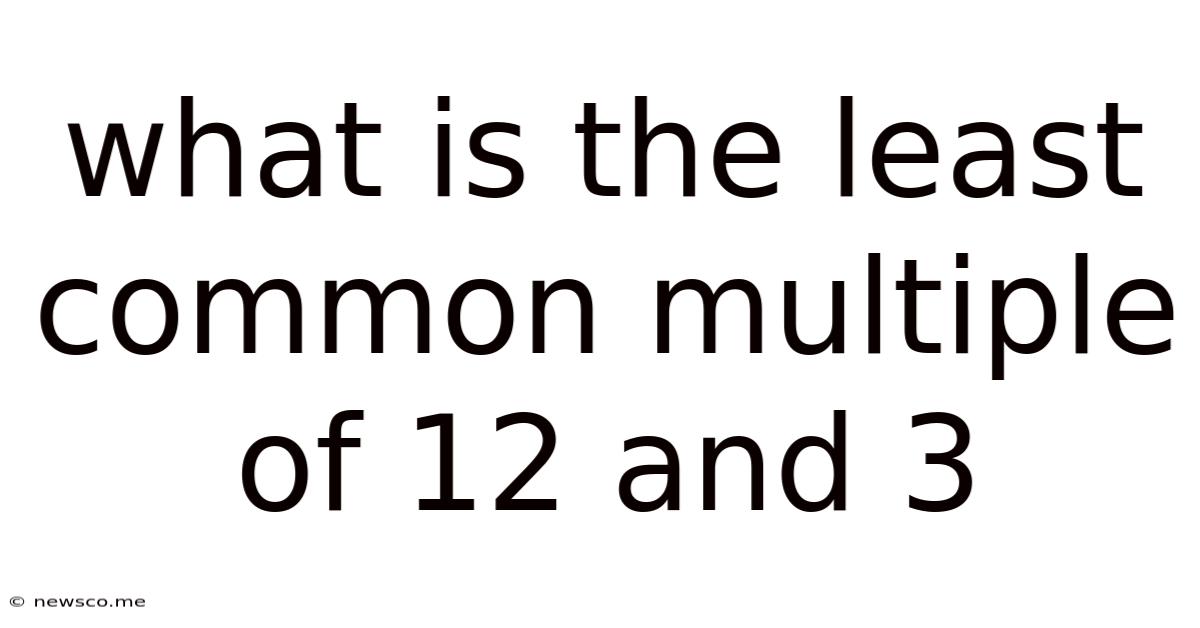What Is The Least Common Multiple Of 12 And 3
News Co
Mar 17, 2025 · 5 min read

Table of Contents
What is the Least Common Multiple (LCM) of 12 and 3? A Deep Dive into Number Theory
The question, "What is the least common multiple of 12 and 3?" might seem trivial at first glance. However, understanding how to find the LCM, and more importantly, why we find it, unlocks a deeper understanding of fundamental mathematical concepts crucial in various fields, from music theory to computer science. This article will delve into the intricacies of finding the LCM of 12 and 3, exploring different methods and demonstrating their applications. We'll also explore the broader context of LCMs within number theory.
Understanding Least Common Multiples (LCMs)
The least common multiple (LCM) of two or more integers is the smallest positive integer that is divisible by all the integers without leaving a remainder. Think of it as the smallest number that contains all the factors of the given numbers. In simpler terms, it's the smallest number that all the numbers can divide into evenly.
For example, let's consider the numbers 4 and 6. The multiples of 4 are 4, 8, 12, 16, 20, and so on. The multiples of 6 are 6, 12, 18, 24, and so on. The common multiples of 4 and 6 are 12, 24, 36, and so on. The least common multiple is 12.
Finding the LCM of 12 and 3: Three Methods
Now, let's tackle the specific question: what is the LCM of 12 and 3? We can use several methods to solve this:
Method 1: Listing Multiples
The most straightforward method is to list the multiples of each number and find the smallest common one.
- Multiples of 12: 12, 24, 36, 48, 60...
- Multiples of 3: 3, 6, 9, 12, 15, 18, 21, 24...
By comparing the lists, we see that the smallest common multiple is 12.
Method 2: Prime Factorization
This method is more efficient for larger numbers. We first find the prime factorization of each number:
- Prime factorization of 12: 2 x 2 x 3 = 2² x 3
- Prime factorization of 3: 3
To find the LCM, we take the highest power of each prime factor present in either factorization and multiply them together:
LCM(12, 3) = 2² x 3 = 4 x 3 = 12
Method 3: Using the Formula (for two numbers)
There's a formula that relates the LCM and the Greatest Common Divisor (GCD) of two numbers:
LCM(a, b) = (|a x b|) / GCD(a, b)
Where:
- a and b are the two numbers.
- |a x b| represents the absolute value of the product of a and b.
- GCD(a, b) is the greatest common divisor of a and b.
First, we need to find the GCD of 12 and 3. The GCD is the largest number that divides both 12 and 3 without leaving a remainder. In this case, the GCD(12, 3) = 3.
Now, we can apply the formula:
LCM(12, 3) = (|12 x 3|) / GCD(12, 3) = 36 / 3 = 12
Why is Finding the LCM Important?
The LCM isn't just an abstract mathematical concept; it has practical applications in various fields:
1. Fractions: Finding a Common Denominator
When adding or subtracting fractions with different denominators, we need to find a common denominator – and the LCM is the smallest common denominator. Using the LCM simplifies calculations and avoids unnecessarily large numbers. For example, adding 1/3 and 1/12 requires finding a common denominator, which is the LCM of 3 and 12 (which is 12).
2. Scheduling and Timing Problems
Imagine two machines that operate on different cycles. One machine completes a task every 12 minutes, while another completes the same task every 3 minutes. To find when both machines will complete the task simultaneously, we need the LCM. The LCM(12, 3) = 12, meaning both machines will finish simultaneously after 12 minutes.
3. Music Theory
In music, the LCM is used to determine the least common multiple of note durations. This is crucial for creating harmonious melodies and rhythmic patterns.
4. Computer Science
The LCM plays a role in algorithms related to scheduling, synchronization, and signal processing.
Exploring the Relationship Between LCM and GCD
The LCM and GCD are closely related. For any two positive integers a and b:
LCM(a, b) x GCD(a, b) = a x b
This relationship highlights the interconnectedness of these two fundamental concepts in number theory. Understanding this connection allows for more efficient calculations and a deeper appreciation of the underlying mathematical structures.
Beyond Two Numbers: Finding the LCM of Multiple Integers
The methods we've discussed can be extended to find the LCM of more than two integers. The prime factorization method remains particularly useful for this purpose. For example, let's find the LCM of 12, 3, and 6:
- Prime factorization of 12: 2² x 3
- Prime factorization of 3: 3
- Prime factorization of 6: 2 x 3
The LCM will be 2² x 3 = 12.
Conclusion: The Significance of the LCM
The seemingly simple question of finding the LCM of 12 and 3 opens a door to a rich world of mathematical concepts and applications. Mastering the various methods for calculating the LCM and understanding its significance in different fields is crucial for anyone pursuing a deeper understanding of mathematics and its practical implications. From everyday tasks to complex algorithms, the LCM plays a significant role, underscoring its fundamental importance in numerous areas. The seemingly simple answer – 12 – represents a powerful concept with widespread applicability.
Latest Posts
Related Post
Thank you for visiting our website which covers about What Is The Least Common Multiple Of 12 And 3 . We hope the information provided has been useful to you. Feel free to contact us if you have any questions or need further assistance. See you next time and don't miss to bookmark.